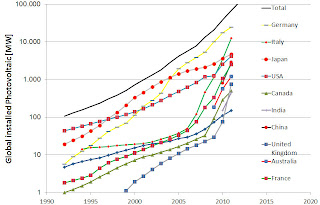Within human history, we have seen four times, where the primary energy source changed.
The first and most significant moment in energy history was the control of
fire. It gave us something, no animal ever had, heat and light, independent of the environment. But as burning wood was the widespread source of energy, it got rare and too expensive for burning anywhere.
The second change was the move to
coal, including the development of the steam power engines. It gave us independence from the location for mechanical work. Before the steam power age, at some places, water power had some impact on production. Burning coal is cheap, but coal is finite and the carbon dioxide emission seems to be a serious threat to the climate.
The third change was
oil. Combined with the ford car, it gave us mobility on land, and a bit later, in the air. The 20th century was the golden age of stored energy in mineral oil. After peak oil at the beginning of the 21st century, it is not a good idea, to rely on this energy source forever.
The fourth change never made it to the top level, it is
the nuclear power, a very strong power source, but also a very dangerous fire. It started with the atom bomb and was controlled to some level in nuclear power plants. Due to human frailties resulting in design and operation errors of facilities, some power plants failed
disastrously.
With the upcoming of the silicon age for semiconductors, a small niche appeared for the use of silicon. Solar cells on satellites for energy supply. Invisible small amounts of energy were generated in the 70´s, first attempts for commercial use started in the 80´s, continuous growth began in the 90´s and as a trend, every 18 months since then, the global
photovoltaic installation doubled. This is called an exponential growth. You see just nothing at the beginning, and after some time astonishing things happen.
This
fifth energy source is different to the accustomed energy sources we have seen in history, it does not contain an inherent storage system, so we have to care about energy storage!
Concluding this, my thesis is:
- Within the next 20 years, photovoltaic will be the primary energy source of the globe
- Energy storage will be the most critical point of this change
Keeping this in mind, my blog will tell you the story of this fascinating change in human energy generation. You have the chance, to watch live the biggest and last change in energy supply of mankind!


